On their run to the semi-final of the FIFA Women’s World Cup, England have owed much of their success to the quality of right-back Lucy Bronze. The Olympique Lyonnais star has been recognised as one of the best in her position for a number of years, and her performances this summer have only served to consolidate that status.
Born to a Portuguese father and an English mother, Bronze began her senior career at Sunderland. Following a brief spell in the USA, she went on to play for Everton, Liverpool and Manchester City.
In the summer of 2017, the three-time Women’s Super League champion opted for a new challenge abroad, signing for French giants Lyon. Since then, she has added a UEFA Women’s Champions League to her extensive list of honours, while also continuing to excel on the international stage.
In this tactical analysis, we will examine the attributes that have taken Bronze to the summit of women’s football.
Inverted full-back and underlapping movements
As the position has evolved in recent years, full-backs are expected to serve their team in a more varied manner. Not only do they require the attributes to add width to the attack, they must also possess the close control and passing abilities needed to provide support in central areas.
Pep Guardiola’s sides have perhaps been the most famous example of the inverted full-back concept, with the likes of David Alaba and Philipp Lahm alternating their positional play between the wings and the deep half-spaces. Phil Neville has also made use of these tactics since taking over as England womens manager last year.
Preferring to play with a single pivot in a 4-1-4-1 system, Neville tasks one of the full-backs with making regular movements infield to support the holding player, both in circulating possession and ring-fencing behind the attack.
Bronze is particularly useful in this regard, with the right-back often carrying the ball through gaps in the opponent’s midfield line. Her coach at Lyon, Reynald Pedros, also recognises the value in giving her license to roam.
In the sequence shown below, the 27-year-old notices the disjointed nature of Barcelona’s midfield in a moment of transition. Instead of feeding her winger and driving forward on the overlap, she dribbles through the central space.
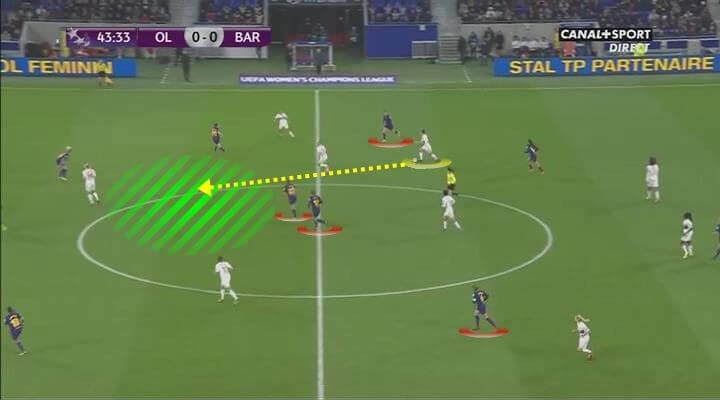
Having arrived in the final third, Bronze has the vision and composure to find a teammate in behind with a perfectly weighted through ball. Germany international Dzsenifer Marozsan finishes the move to give her side the lead.
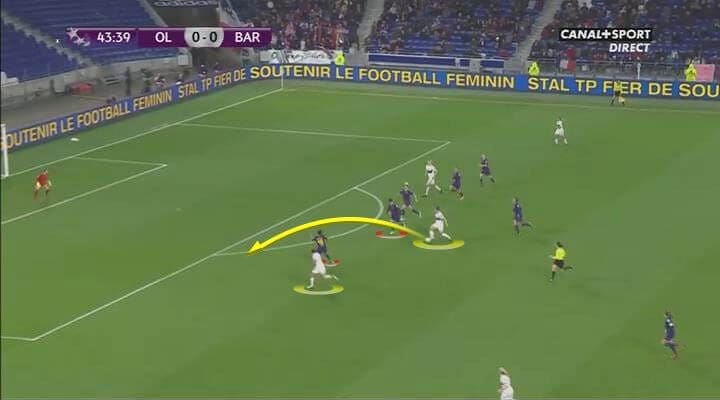
Diagonal dribbles have also been on show from Bronze at this summer’s World Cup. In the Lionesses’ round of 16 encounter with Cameroon, she assisted Ellen White for their second goal by carrying the ball into the ten space.
In the image below, we see her arrive in the final third after beginning the move in her usual full-back spot. She plays a lofted through ball to evade three defenders, picking out White with just the keeper to beat.
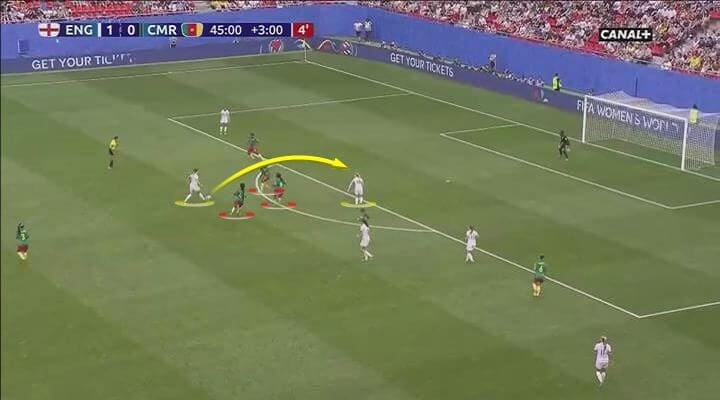
While inverted movements with the ball form a significant part of her offensive game, she is also excellent at making underlapping movements without the ball. When Nikita Parris is in possession on the right wing, multiple opposing players will often be drawn towards her. This leads to spaces opening up through the middle, and Bronze is consistently on hand to profit.
In the example below, two Brazil defenders are engaged by Parris on the flank. Bronze recognises the space on the right side of the penalty area, before making an underlapping run to receive from her soon-to-be Lyon teammate. Having taken the ball in a dangerous position, she drives a low cross towards the near post, with Frank Kirby missing the target.
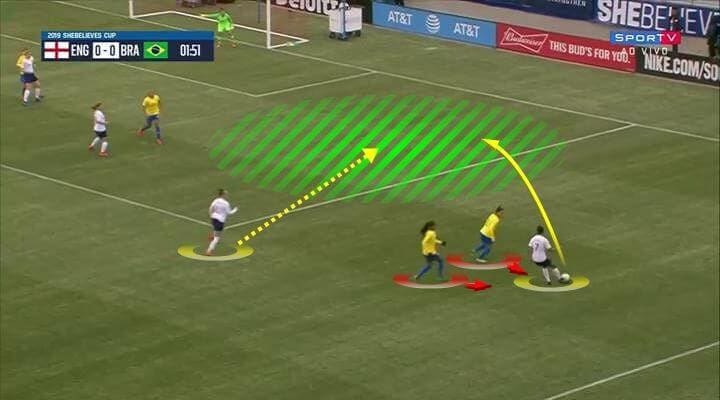
As we will see in the next section of this analysis, Bronze possesses the required qualities to exploit the wings. However, her close control, vision, and spatial awareness make her equally useful in central areas. She has an overall pass accuracy of 80%, just two lower than holding midfielder Keira Walsh. She also attempts 4.14 dribbles per 90, with a success rate of 69.3%. USA’s right-back during the Women’s World Cup, Kelley O’Hara, attempts on average 1.92 dribbles, succeeding with 46.7%.
Precise deliveries and offensive 1v1s
While Neville allows Bronze to move inside and engage in England’s attempts to progress via the centre, he also wants her to provide width where neccesary. Parris excels in one v ones close to the touchline, but is similarly competent in more congested spaces infield. When the 25-year-old makes inverted movements to join the attack, she knows that her full-back has the capacity to fill in out wide.
As mentioned, Bronze has all the requirements to support her team from the flanks. Her crossing is remarkably accurate, finding a teammate 50% of the time. To put this statistic in context, O’Hara has an overall accuracy of 36.4%. Meanwhile, France right-back Marion Torrent is successful with 30.4% of her crosses.
Given that crossing is generally a low-percentage action, the numbers being recorded by her rivals are, in actual fact, relatively impressive. The fact that Bronze hits her target with every second attempt is exceptional.
The example below shows her pick out Jill Scott in the box for a headed attempt on goal. With an Argentinian defender ready to clear the danger at the front post, the weight on the cross needed to be perfect to prevent the interception.
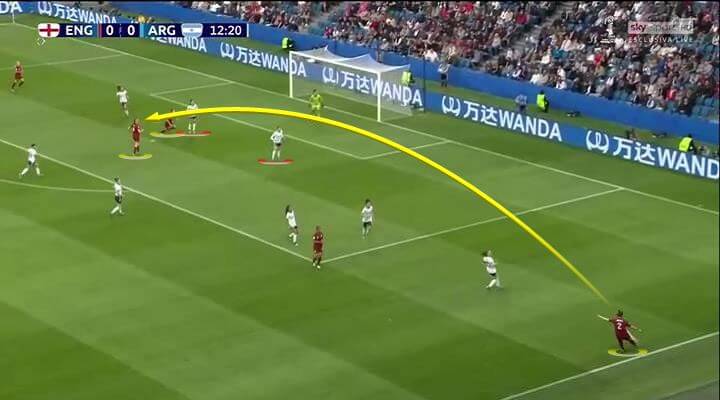
Earlier, we saw Bronze dribbling through central gaps to progress the play into the final third. Her close control also aids her in one v one scenarios out wide. Many full-backs need to arrive onto the ball in order to be effective, often lacking the skillset to overcome direct opponents on their own.
Bronze, however, is comfortable receiving to feet with a defender in front of her. In the image below, she bypasses the Norway left-back before picking out Scott for the game’s opening goal.
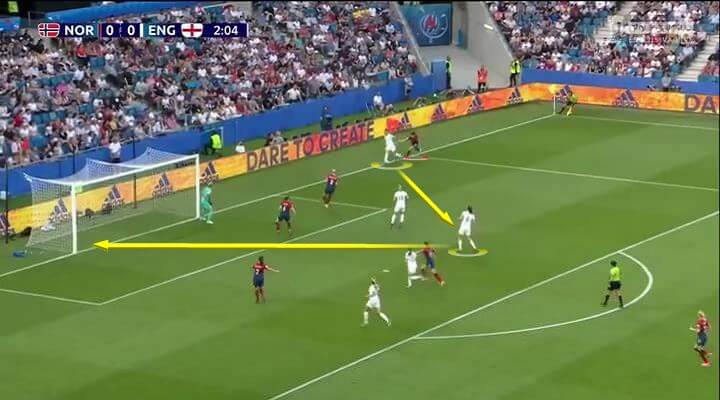
Her abilities in offensive duels are again illustrated by the next example. The ball falls to Bronze outside the box in the right half-space, with Scotland’s Nicola Docherty rushing out to close her down. She recognises the space left behind the defender and heads the ball beyond her.
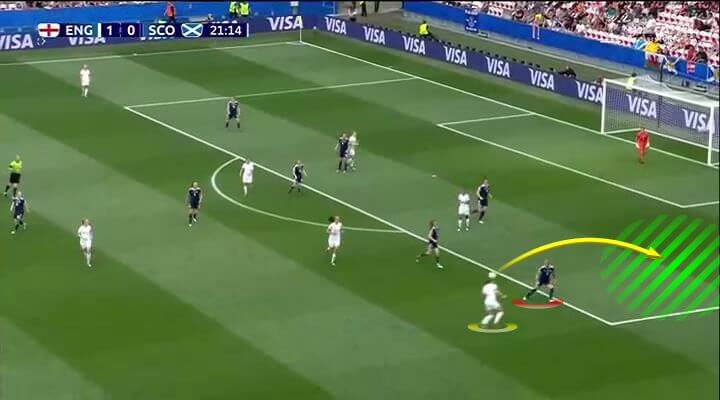
She uses her pace to bypass the opposing player, before supplying an accurate cross to White on the six-yard line. Having scanned her surroundings before executing the final action, Bronze knows precisely where the centre-foward is, as well as the positioning of the opponent at the near post. Her delivery loops over the first defender, falling perfectly for White to shoot first-time.
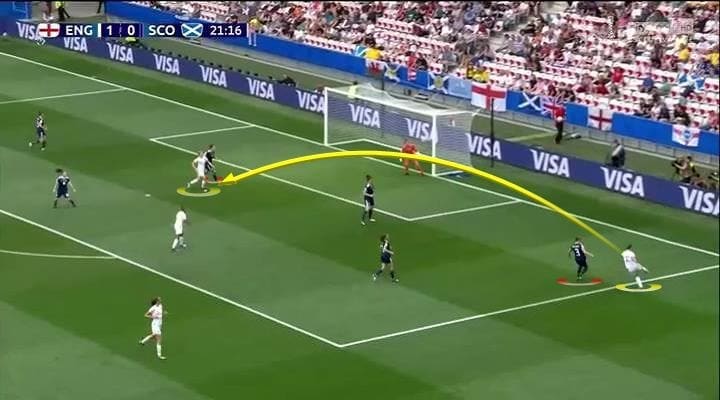
Bronze’s predecessor in the England team, Alex Scott, labeled her as the best right-back in the world following the 3-0 win over Norway, also noting the challenges that come with such recognition.
“She has to deal with people knowing her game. She showed why she is the best right-back in the world. She loves a challenge, tell her ‘you are the best, now you have to be the best player in the world’ and she rises to that.”
It may be true that as a player’s stock rises, opponents put more of an emphasis on stifling them. However, the sheer level of variation in Bronze’s game makes it almost impossible to prevent her from having some kind of significant influence.
Defensive 1v1s and interceptions
So far, this scout report has shown Bronze’s qualities in possession. During the defensive phases, she is equally proficient. Throughout her career, the teams she has played for have been mainly protagonistic in their approach. As a result, she rarely finds herself defending for long spells deep in her own half.
Instead, she is often expected to counterpress following a turnover, as well as being required to cover large spaces in behind. The two-time PFA Womens Player of the Year has the pace and energy to execute these scenarios well, while she also has the ability to read the opponent’s intentions and defend proactively.
Bronze recently spoke about how the transfer to Lyon helped with accelerating her development. With so many world-class performers to compete with, she needed to adapt quickly in order to succeed.
”In training it’s 11 internationals v 11 internationals, so I’m having to defend against the world’s best strikers every day. At the start it was hard, and for the first month I couldn’t get near the ball in training. Then I got up to speed. It’s definitely been the right move.”
While her offensive game has gone from strength to strength since moving to France, she has also taken her defensive performances to another level.
In the example below, Bronze anticipates the direction of a Cameroonian player’s pass. Rather than overcommitting and handing the advantage to the opponent, she waits for the action before stepping out to intercept as the ball travels.
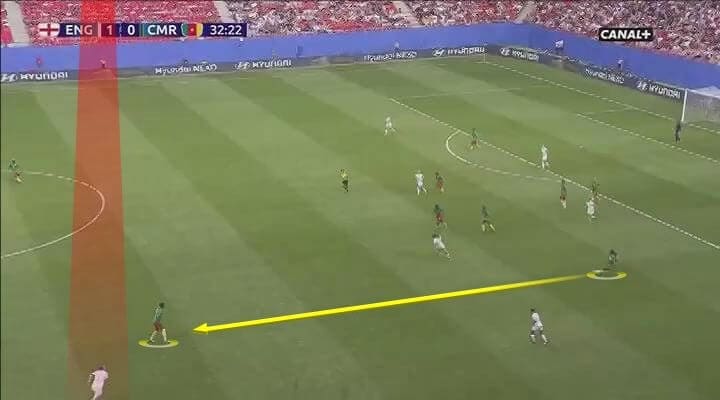
Having successfully cut out the pass, Bronze looks to get her side on the attack instantly with a first-time ball towards Scott. This moment illustrates her ability to read the game, but also shows her intelligence in knowing the right moment to act. Had she pushed up too soon, she would have left space behind her, and the ball-occupant could have changed her pass selection to exploit this disposition accordingly.
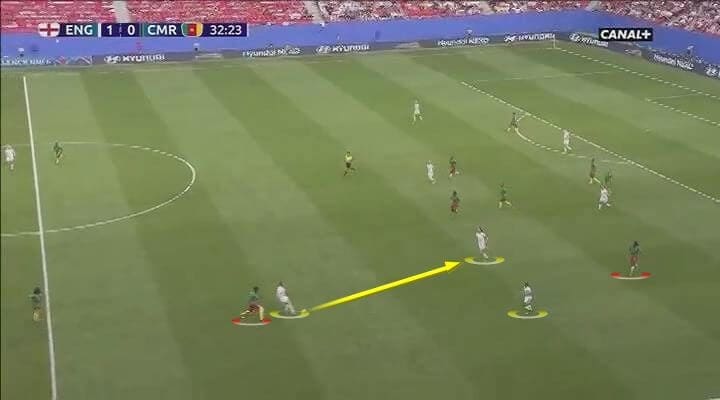
When the opposing team does manage to progress their attack into the final third, Bronze also favours a proactive approach. She will often move out quickly to close down her direct opponent, before decreasing the options available to the attacker with the appropriate body orientation.
In the sequence below, the full-back takes a side on stance, ushering the winger down the line and onto her weaker left foot. She also makes sure that the nearest available passing option is blocked off by her cover shadow.
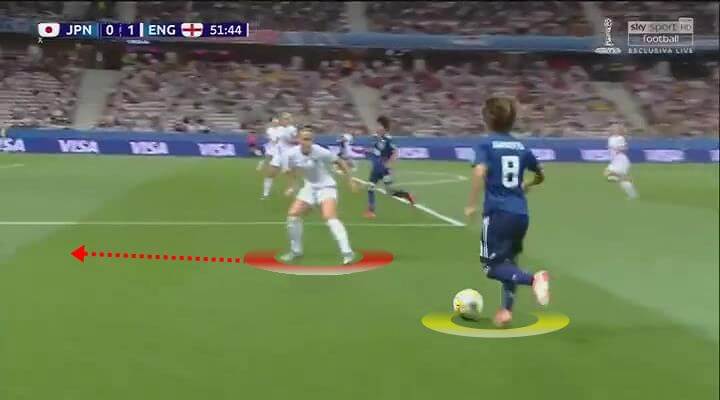
Having created a race to the byline, Bronze executes the timing of her tackle well to clear the ball out for a throw-in. While it wasn’t the case in this particular instance, it isn’t uncommon to see her complete a turnover close to her own goal before calmly passing out from the back under intense counter-pressure.
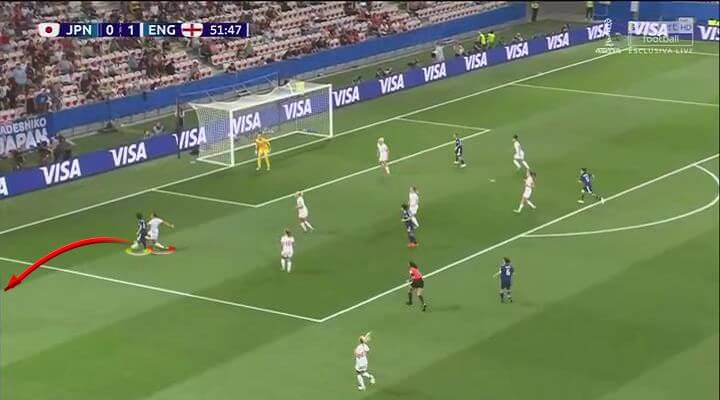
Especially during this summer’s World Cup, Bronze has proven herself to be just as effective without the ball as she is with it. On average, she makes a total of 5.7 interceptions per game, as well as completing 12.62 recoveries.
Goalscoring potential
Given her tendency to roam infield, Bronze sometimes finds herself on the end of goalscoring opportunities. In her 73 appearances for England, she has contributed eight goals. Perhaps the pick of the bunch, she capped off the Lionesses’ quarter-final victory over Norway with a thunderous effort from outside the box.
Having received on the edge of the penalty area from Beth Mead’s free-kick, Bronze fires through a crowd of bodies to find the roof of the net. Such was the velocity of the strike, as well as the sheer amount of players in her way, the ball had already gone past Norwegian goalkeeper Ingrid Hjelmseth before she mustered an attempt to stop it.
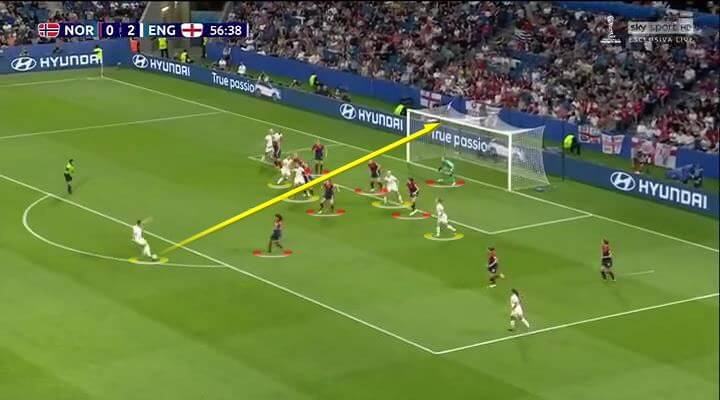
David Beckham nodded in approval from the stands of the Stade Oceane, while manager Phil Neville was full of praise after the game.
“What you have seen tonight is that Lucy Bronze is the best player in the world: there is no player like her, no player who has her athleticism and quality. I played full-back but never to that level.”
While the previous goal showed her ability to score from range, she is also capable of making intelligent movements to arrive in the box. On occasions where her teammate on the same flank is holding the width, Bronze will often make darting runs towards the penalty area to provide another crossing option.
When the ball is on the opposite wing, she sometimes chooses to make late runs to receive at the back post. In the example shown below, the Sunderland academy graduate gets on the end of a cross from the far side. She fires a volley beyond Manchester City goalkeeper Karen Bardsley and into the top corner, putting Lyon in front against her former club.
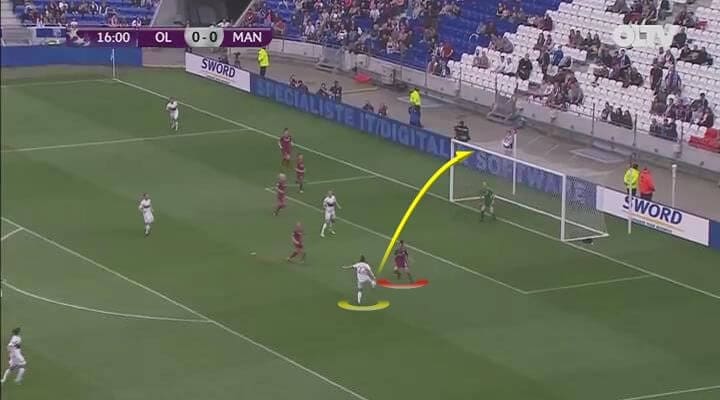
Based on the nature of the two goals shown in this section, it won’t come as much of a surprise to hear that Bronze generally outperforms her expected goals tally each season. She found the back of the net twice last year, despite an xG total of 1.08. Meanwhile, the 2017/18 campaign saw her score three, recording an xG of 2.01.
Conclusion
This tactical analysis has shown why Lucy Bronze is regarded as one of the stars of the women’s game. She has a huge impact on the way her teams play, providing them with multiple dimensions in the attacking phases. Her defensive output is also impressive, making her an exceptionally well-rounded player.
Having already conquered club football, she will be desperate to cap off a perfect career by securing major honours at international level. Tuesday night sees the Lionesses battle tournament favourites USA for a place in the final. The last World Cup saw England finish third, and they’ll be hoping to convert bronze to gold this time around.
If you love tactical analysis, then you’ll love the digital magazines from totalfootballanalysis.com – a guaranteed 100+ pages of pure tactical analysis covering topics from the Premier League, Serie A, La Liga, Bundesliga and many, many more. Buy your copy of the June issue for just ₤4.99 here, or even better sign up for a ₤50 annual membership (12 monthly issues plus the annual review) right here.






Comments